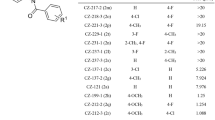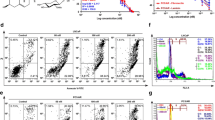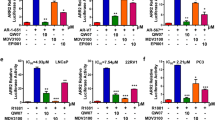Summary
Targeting androgen receptor (AR) signaling with agents distinct from current antagonist drugs remains a rational approach to the prevention and treatment of prostate cancer (PCa). Our previous studies have shown that decursin and isomer decursinol angelate (DA), isolated from the Korean medicinal herb Angelica gigas Nakai, interrupt AR signaling and possess anti-PCa activities in vitro. In the LNCaP PCa cell model, these pyranoccoumarin compounds exhibit properties distinct from currently used antagonists (e.g., Casodex). However, both are rapidly de-esterified to decursinol, a partial AR agonist. We report here that a synthetic decursin analog, decursinol phenylthiocarbamate (DPTC), has greater in vivo stability than the parent compounds. DPTC-decursinol conversion was undetectable in mice. Furthermore, in LNCaP cells, DPTC decreased prostate specific antigen (PSA) expression, down-regulated AR abundance and mRNA and inhibited AR nuclear translocation. The effect of DPTC on AR and PSA mRNA and protein abundance was also observed in VCaP cells expressing wild type AR. DPTC inhibited growth of both PCa cell lines through G1 cell cycle arrest and apoptosis, as did decursin and DA. Furthermore, i.p. administration of DPTC for 3 weeks suppressed the expression of AR target genes probasin and Nkx3.1 in mouse prostate glands. Overall, our data suggest that DPTC represents a prototype lead compound for development of in vivo stable and active novel decursin analogs for the prevention or therapy of PCa.





Similar content being viewed by others
References
Jemal A, Siegel R, Xu J, Ward E (2010) Cancer statistics, 2010. CA: A Cancer Journal for Clinicians 60(5):277–300
Heinlein CA, Chang C (2004) Androgen receptor in prostate cancer. Endocr Rev 25(2):276–308
Kung HJ, Evans CP (2009) Oncogenic activation of androgen receptor. Urol Oncol 27(1):48–52
Scher HI, Sawyers CL (2005) Biology of progressive, castration-resistant prostate cancer: directed therapies targeting the androgen-receptor signaling axis. J Clin Oncol 23(32):8253–8261
Petrylak DP (2005) The current role of chemotherapy in metastatic hormone-refractory prostate cancer. Urology 65(5 Suppl):3–7, discussion 7–8
Chen CD, Welsbie DS, Tran C, Baek SH, Chen R, Vessella R, Rosenfeld MG, Sawyers CL (2004) Molecular determinants of resistance to antiandrogen therapy. Nature medicine 10(1):33–39
Li TH, Zhao H, Peng Y, Beliakoff J, Brooks JD, Sun Z (2007) A promoting role of androgen receptor in androgen-sensitive and -insensitive prostate cancer cells. Nucleic Acids Res 35(8):2767–2776
Tran C, Ouk S, Clegg NJ, Chen Y, Watson PA, Arora V, Wongvipat J, Smith-Jones PM, Yoo D, Kwon A, Wasielewska T, Welsbie D, Chen CD, Higano CS, Beer TM, Hung DT, Scher HI, Jung ME, Sawyers CL (2009) Development of a second-generation antiandrogen for treatment of advanced prostate cancer. Science (New York) 324(5928):787–790
Attard G, Reid AH, A'Hern R, Parker C, Oommen NB, Folkerd E, Messiou C, Molife LR, Maier G, Thompson E, Olmos D, Sinha R, Lee G, Dowsett M, Kaye SB, Dearnaley D, Kheoh T, Molina A, de Bono JS (2009) Selective inhibition of CYP17 with abiraterone acetate is highly active in the treatment of castration-resistant prostate cancer. J Clin Oncol 27(23):3742–3748
Scher HI, Beer TM, Higano CS, Anand A, Taplin ME, Efstathiou E, Rathkopf D, Shelkey J, Yu EY, Alumkal J, Hung D, Hirmand M, Seely L, Morris MJ, Danila DC, Humm J, Larson S, Fleisher M, Sawyers CL (2010) Antitumour activity of MDV3100 in castration-resistant prostate cancer: a phase 1–2 study. Lancet 375(9724):1437–1446
Han D (1992) Pharmacognosy, 4th edn. Dongmyungsa Press, Seoul
Jiang C, Lee HJ, Li GX, Guo J, Malewicz B, Zhao Y, Lee EO, Lee JH, Kim MS, Kim SH, Lu J (2006) Potent antiandrogen and androgen receptor activities of an Angelica gigas-containing herbal formulation: identification of decursin as a novel and active compound with implications for prevention and treatment of prostate cancer. Cancer research 66(1):453–463
Guo J, Jiang C, Wang Z, Lee HJ, Hu H, Malewicz B, Lee HJ, Lee JH, Baek NI, Jeong JH, Kim DK, Kang KS, Kim SH, Lu J (2007) A novel class of pyranocoumarin anti-androgen receptor signaling compounds. Mol Canc Therapeut 6(3):907–917
Lu J, Kim S, Jiang C, Lee H, Guo J (2007) Oriental herbs as a source of novel anti-androgen and prostate cancer chemopreventive agents. Acta Pharmacol Sin 28(9):1365–1372
Yim D, Singh RP, Agarwal C, Lee S, Chi H, Agarwal R (2005) A novel anticancer agent, decursin, induces G1 arrest and apoptosis in human prostate carcinoma cells. Cancer Res 65(3):1035–1044
Lee HJ, Lee EO, Lee JH, Lee KS, Kim KH, Kim SH, Lu J (2009) In vivo anti-cancer activity of Korean Angelica gigas and its major pyranocoumarin decursin. Am J Chin Med 37(1):127–142
Song GY, Lee JH, Cho M, Park BS, Kim DE, Oh S (2007) Decursin suppresses human androgen-independent PC3 prostate cancer cell proliferation by promoting the degradation of beta-catenin. Mol Pharmacol 72(6):1599–1606
Kim WJ, Lee SJ, Choi YD, Moon SK (2010) Decursin inhibits growth of human bladder and colon cancer cells via apoptosis, G1-phase cell cycle arrest and extracellular signal-regulated kinase activation. Int J Mol Med 25(4):635–641
Jiang C, Guo J, Wang Z, Xiao B, Lee HJ, Lee EO, Kim SH, Lu J (2007) Decursin and decursinol angelate inhibit estrogen-stimulated and estrogen-independent growth and survival of breast cancer cells. Breast Cancer Res 9(6):R77
Lee S, Lee YS, Jung SH, Shin KH, Kim BK, Kang SS (2003) Anti-tumor activities of decursinol angelate and decursin from Angelica gigas. Arch Pharm Res 26(9):727–730
Kim HH, Sik Bang S, Seok Choi J, Han H, Kim IH (2005) Involvement of PKC and ROS in the cytotoxic mechanism of anti-leukemic decursin and its derivatives and their structure-activity relationship in human K562 erythroleukemia and U937 myeloleukemia cells. Cancer letters 223(2):191–201
Park R, Kim N, Lee K, Seo S (2001) Comparative studies on concentration of decursinol in plasma after oral administration of Angelica gigantis radix extract and combined use of decursin and Cnidii rhizoma extract or Bupleuri radix extract in rats. Korean J Pharmacogn 32(72–78)
Lee S, Kang S, Shin K (2002) Coumarins and a pyrimidine from Angelica gigas roots. Nat Product Sci 8:58–61
Kang Y, Lee J, Chae H, Kim D, Lee S, Park S (2003) HPLC analysis and extraction method of decursin and decursinol angelate in A. gigas roots. Korean J Pharmacol 34:201–205
Li L, Zhang J, Shaik A, Zhang Y, Wang L, Xing C, Kim S, Lü J (2011) Determination of decursin, decursinol angelate and decursinol simultaneously in mouse plasma and tumor tissue by liquid-liquid extraction and HPLC. J Pharm Biomed Anal. Submitted
Cho SD, Jiang C, Malewicz B, Dong Y, Young CY, Kang KS, Lee YS, Ip C, Lu J (2004) Methyl selenium metabolites decrease prostate-specific antigen expression by inducing protein degradation and suppressing androgen-stimulated transcription. Mol Canc Therapeut 3(5):605–611
Xu LL, Srikantan V, Sesterhenn IA, Augustus M, Dean R, Moul JW, Carter KC, Srivastava S (2000) Expression profile of an androgen regulated prostate specific homeobox gene NKX3.1 in primary prostate cancer. J Urol 163(3):972–979
Rennie PS, Bruchovsky N, Leco KJ, Sheppard PC, McQueen SA, Cheng H, Snoek R, Hamel A, Bock ME, MacDonald BS et al (1993) Characterization of two cis-acting DNA elements involved in the androgen regulation of the probasin gene. Mol Endocrinol 7(1):23–36
Zhang Y, Kim KH, Zhang W, Guo Y, Kim SH, Lu J (2011 Feb 15) [Epub ahead of print]) Galbanic acid decreases androgen receptor abundance and signaling and induces G(1) arrest in prostate cancer cells. Int J Cancer. doi:10.1002/ijc.25993
Malewicz B, Wang Z, Jiang C, Guo J, Cleary MP, Grande JP, Lü J (2006) Enhancement of mammary carcinogenesis in two rodent models by silymarin dietary supplements. Carcinogenesis 27(9):1739–1747
Maestro, version 9.0 (2009) Schrödinger, LLC, New York, NY
Sherman W, Day T, Jacobson MP, Friesner RA, Farid R (2006) Novel procedure for modeling ligand/receptor induced fit effects. J Med Chem 49(2):534–553
Glide, version 5.0 (2009). Schrödinger, LLC, New York, NY
Masiello D, Cheng S, Bubley GJ, Lu ML, Balk SP (2002) Bicalutamide functions as an androgen receptor antagonist by assembly of a transcriptionally inactive receptor. J Biol Chem 277(29):26321–26326
Fu R, Liu J, Fan J, Li R, Li D, Yin J, Cui S (2011) Novel evidence that testosterone promotes cell proliferation and differentiation via G protein-coupled receptors in the rat L6 skeletal muscle myoblast cell line. J Cell Physiol. doi:10.1002/jcp.22710, [Epub ahead of print]. Mar 3
Acknowledgement
We acknowledge the assistance of Ellen Kroc and animal facility staff and Todd Schuster of Shared Instruments Core facility for help with flow cytometric analyses. We thank Dr. Margret Weis for extensive copy editing of the manuscript during revision.
Author information
Authors and Affiliations
Corresponding authors
Additional information
Grant supports
National Center for Complementary and Alternative Medicine AT 005383, University of Minnesota Cancer Center Breast Cancer Seed grant CON000000015215, Korea Science and Engineering Foundation (KOSEF) grant No. 2011–0006220.
Rights and permissions
About this article
Cite this article
Zhang, Y., Shaik, A.A., Xing, C. et al. A synthetic decursin analog with increased in vivo stability suppresses androgen receptor signaling in vitro and in vivo . Invest New Drugs 30, 1820–1829 (2012). https://doi.org/10.1007/s10637-011-9738-x
Received:
Accepted:
Published:
Issue Date:
DOI: https://doi.org/10.1007/s10637-011-9738-x




